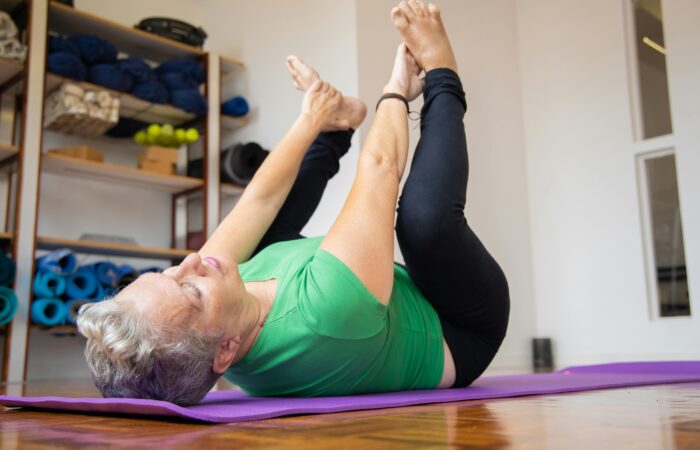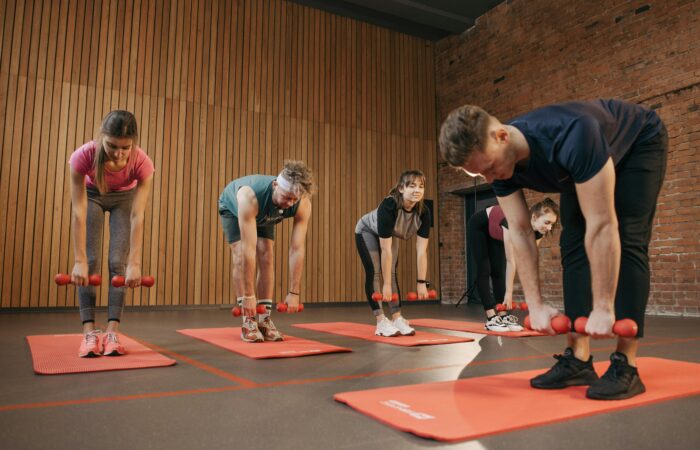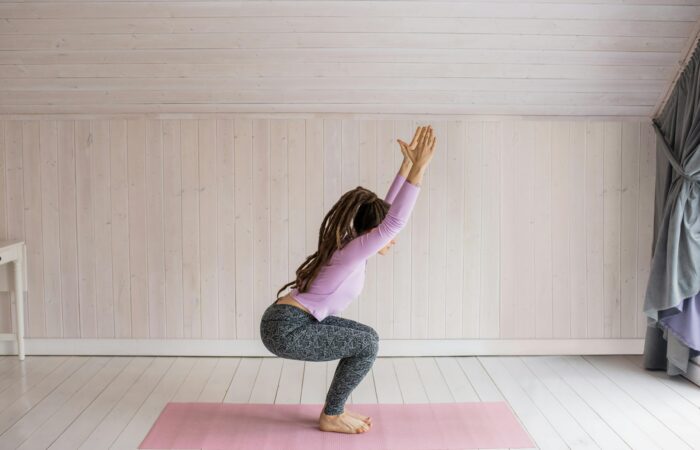When it comes to fitness, staying consistent can be a challenge in and of itself. Life is busy—between work, family obligations, social events, and day-to-day tasks, it can feel nearly impossible to establish a steady workout regimen that sticks. That’s where monthly workout challenges come in. By focusing on one specific fitness challenge each month, you create a structured approach that keeps you motivated, engaged, and steadily working toward long-term goals.
A monthly workout challenge has a few distinct advantages. First, it’s digestible. Anyone can commit to a challenge that lasts 30 days, rather than feeling overwhelmed by an open-ended or year-long endeavor. Second, it’s measurable. Over the course of a month, you can track your progress, record your achievements, and see tangible improvements in your strength, endurance, and overall fitness. Lastly, it’s an excellent way to maintain variety in your workouts. Each month, you switch gears, exploring new exercises that train different muscle groups and skills. This not only keeps fitness fun but also prevents the dreaded workout plateau.
Below, you’ll find a year’s worth of monthly workout challenges. Each one focuses on a different exercise style—ranging from classic bodyweight moves like squats and push-ups to jogging, jump rope, and mindful movement. Feel free to follow them in order or pick and choose the ones that resonate with your current fitness goals. Whatever route you choose, remember: consistency is key. Stick with each challenge for the full 30 days, listen to your body, and celebrate the small victories along the way. By the end of the year, you’ll have explored diverse ways to stay active, built functional strength, and created lasting, healthy habits that will benefit you well beyond these 12 months.

Why Monthly Workout Challenges Work
Before diving into each month’s specific challenge, let’s take a moment to understand why this method is so effective.
- Focus and Motivation: Having a singular, well-defined goal each month cuts out a lot of indecision. Instead of feeling overwhelmed by all the possible workouts, you know exactly what you’re working on every day. This clarity streamlines your approach and often translates to higher motivation.
- Short-Term Commitment with Long-Term Benefits: A month is long enough to see meaningful progress but short enough to avoid burnout or boredom. When 30 days end, you can choose to continue with the challenge if you love it or switch to the next one if you need a change. Over time, these short bursts of focus add up to a robust fitness routine.
- Measurable Progress: Monthly workout challenges usually involve tracking reps, time, distance, or weight. By measuring these markers, you get real feedback on your performance. Seeing improvements—whether it’s holding a plank 15 seconds longer or adding more push-ups—builds confidence and encourages you to keep going.
- Preventing Plateaus: The human body adapts quickly. Doing the same workout for too long might stall your progress. With a new challenge every 30 days, you’ll target different muscle groups, develop new skills, and keep your body guessing. This variety promotes continual growth and prevents fitness plateaus.
- Sense of Community: Many monthly challenges become popular online, with social media groups dedicated to daily check-ins, tips, and encouragement. Sharing your journey with others can amplify accountability and add an element of fun.
Now that you understand the “why,” let’s move on to the “how.” Below, you’ll find 12 monthly challenges that each focus on a unique aspect of fitness—strength, endurance, flexibility, cardiovascular health, and mindfulness. Pick one or try them all throughout the year.
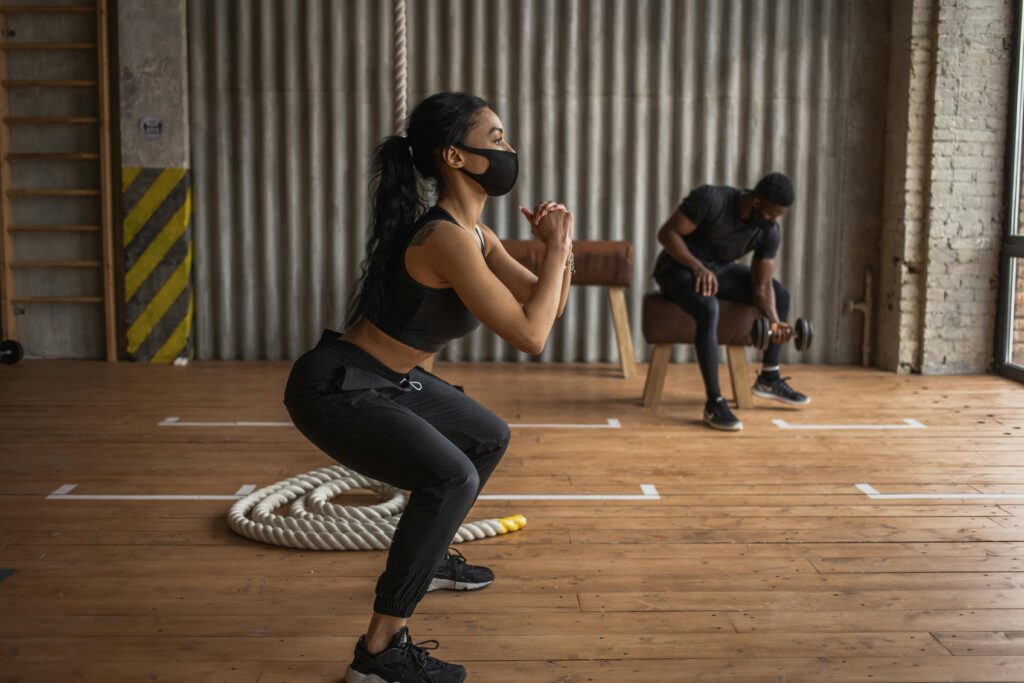
Month 1: 30-Day Squat Challenge
The squat is often hailed as the king of lower-body exercises. It targets your quads, hamstrings, and glutes while also engaging your core for stability. A 30-day squat challenge is an excellent way to start the year with strong foundations.
How It Works
- Baseline Test: On Day 1, perform as many squats as you can with proper form before muscle fatigue sets in. Record this number.
- Incremental Increases: Each day, do 2–5 more squats than the day before. Typically, squat challenge calendars will have you rest every 3–4 days to allow for muscle recovery.
- Proper Form: Ensure your knees track over your toes, your back is straight, and you push through your heels. If standard squats are too easy, incorporate variations like sumo squats or jump squats.
Benefits
- Stronger Legs and Glutes: Squats are a compound movement that effectively builds power in your lower body.
- Core Engagement: Squats require core stability to maintain proper alignment, helping you develop a stronger midsection.
- Functional Movement: Squats mimic everyday activities like sitting down and standing up, thus improving functional strength.
Tips for Success
- Warm up with dynamic stretches (e.g., leg swings, hip circles) before squatting.
- Focus on proper form rather than rushing through reps.
- Track your progress in a journal or app to stay accountable.
By the end of this month, you’ll see tangible improvements in your leg strength and overall endurance, setting the stage for a successful fitness journey in the months ahead.
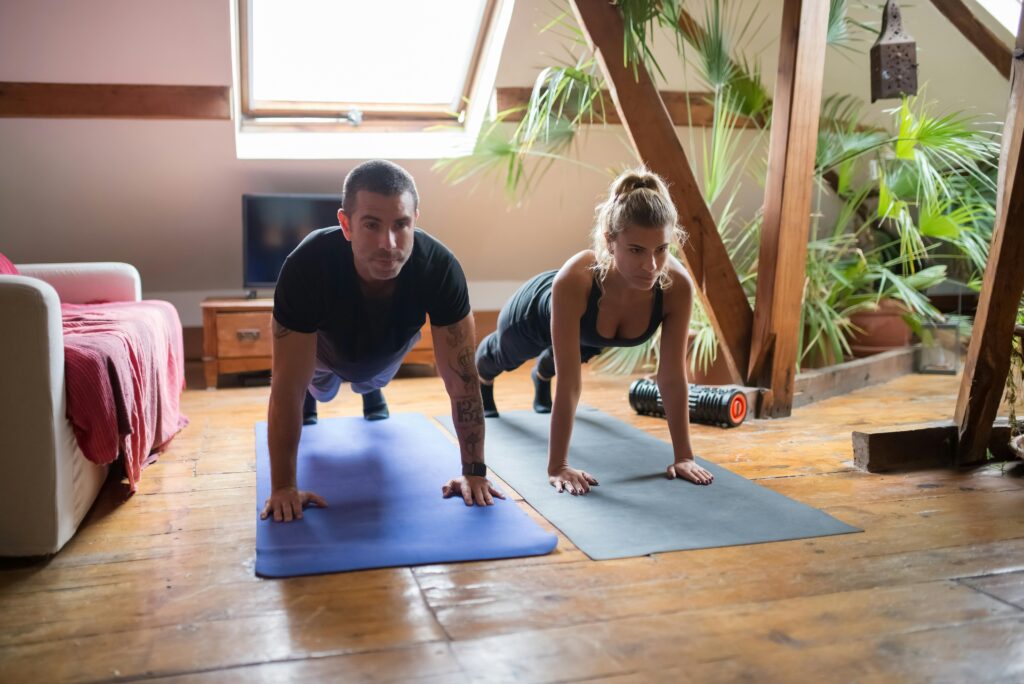
Month 2: 30-Day Plank Challenge
Few exercises rival the plank for building core strength and stability. It looks simple—holding your body in a straight line, supported by your arms and toes—but a plank challenge packs a serious punch.
How It Works
- Baseline Test: Time how long you can hold a perfect plank on Day 1.
- Progressive Holds: Add 5–10 seconds to your plank hold each day or every other day, depending on your fitness level. Most 30-day plank challenges schedule rest days, ensuring recovery for your muscles.
- Variety: Mix it up with side planks, forearm planks, or high planks to challenge different muscle fibers and prevent boredom.
Benefits
- Core Strength: Planks target your abs, obliques, and lower back, helping to improve posture and reduce lower back pain.
- Full-Body Engagement: Though primarily a core exercise, planks also engage the shoulders, arms, glutes, and legs.
- Better Stability and Balance: A strong core is key for virtually every movement, from lifting heavy objects to sprinting.
Tips for Success
- Maintain a neutral spine: avoid letting your hips sag or pike.
- Incorporate additional supporting exercises like bird dogs or dead bugs for an even stronger core.
- Track your time each day to see your improvement in real numbers.
By the end of the 30 days, you’ll likely hold a plank longer than you ever thought possible. You’ll also notice better posture and increased stability in other exercises.
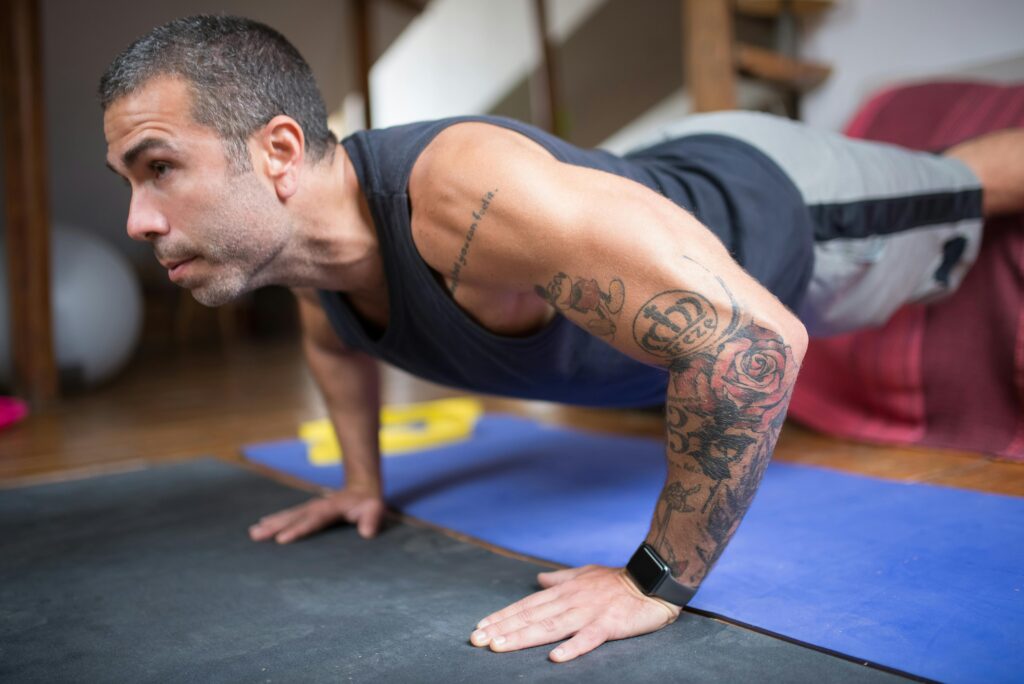
Month 3: 30-Day Push-Up Challenge
The push-up is a cornerstone of upper-body strength. This bodyweight exercise works your chest, shoulders, triceps, and core simultaneously. Perfect for building arm definition and robust upper-body stamina, a push-up challenge can dramatically improve your fitness.
How It Works
- Baseline Test: Do as many push-ups as you can with proper form on Day 1.
- Incremental Reps: Aim to add 1–3 push-ups each day, with rest days built in. Some challenge calendars split these daily reps into multiple sets (e.g., morning, afternoon, evening).
- Adaptations: If standard push-ups are too demanding at first, start with knee push-ups or incline push-ups (hands on a bench or sturdy chair). Progress to standard push-ups as you gain strength.
Benefits
- Chest, Arms, and Shoulders: Push-ups predominantly target your pectoral muscles, deltoids, and triceps, helping to sculpt a toned upper body.
- Core Activation: Like a plank, holding your body straight during push-ups engages your core and lower back muscles.
- Convenience: You can do push-ups anywhere without special equipment, making it easy to stick to the challenge.
Tips for Success
- Keep your elbows close to your torso to protect your shoulders.
- Engage your core and keep a straight line from head to heels.
- Slow down on the eccentric (lowering) phase to build more strength.
After 30 days, you’ll see noticeable increases in upper-body strength and endurance, potentially boosting your confidence in other activities like weightlifting or swimming.
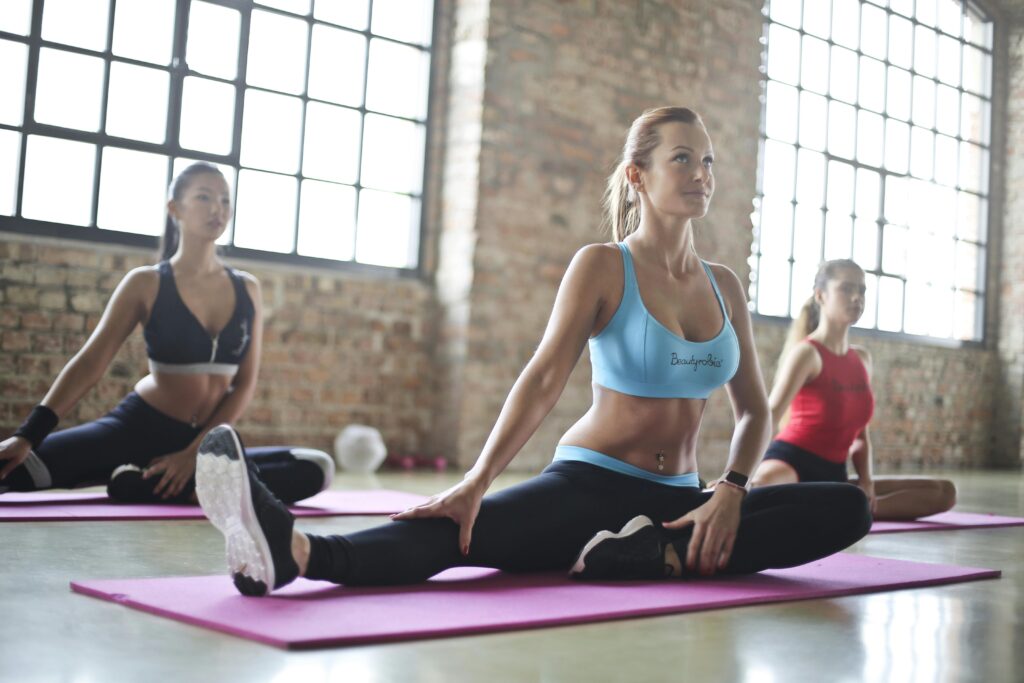
Month 4: 30-Day Yoga Challenge
After three months of focusing on bodyweight strength, it’s time to add some flow and flexibility. A 30-day yoga challenge is a gentle yet powerful way to increase mobility, reduce stress, and cultivate mindfulness.
How It Works
- Daily Practice: Commit to at least 10–15 minutes of yoga daily. You can follow online videos, use an app, or even attend classes.
- Focus on Fundamentals: Key postures like Downward Dog, Warrior I and II, and Child’s Pose form the foundation of many yoga flows.
- Gradual Progression: Over the month, introduce more challenging poses like Crow Pose or Wheel Pose, if you feel comfortable.
Benefits
- Flexibility: Consistent yoga practice helps loosen tight muscles, improving range of motion.
- Stress Reduction: Yoga incorporates breathwork and mindfulness, known to reduce stress and anxiety.
- Postural Alignment: Through poses that focus on alignment, yoga can correct imbalances and postural issues.
Tips for Success
- Listen to your body; never push into pain.
- Focus on your breath, moving slowly and intentionally through each pose.
- Consider keeping a yoga journal, noting which poses felt good and which ones need more practice.
By the end of this challenge, you’ll likely notice a calmer mind, increased flexibility, and better posture—gains that will benefit both your everyday life and any other workouts you do.
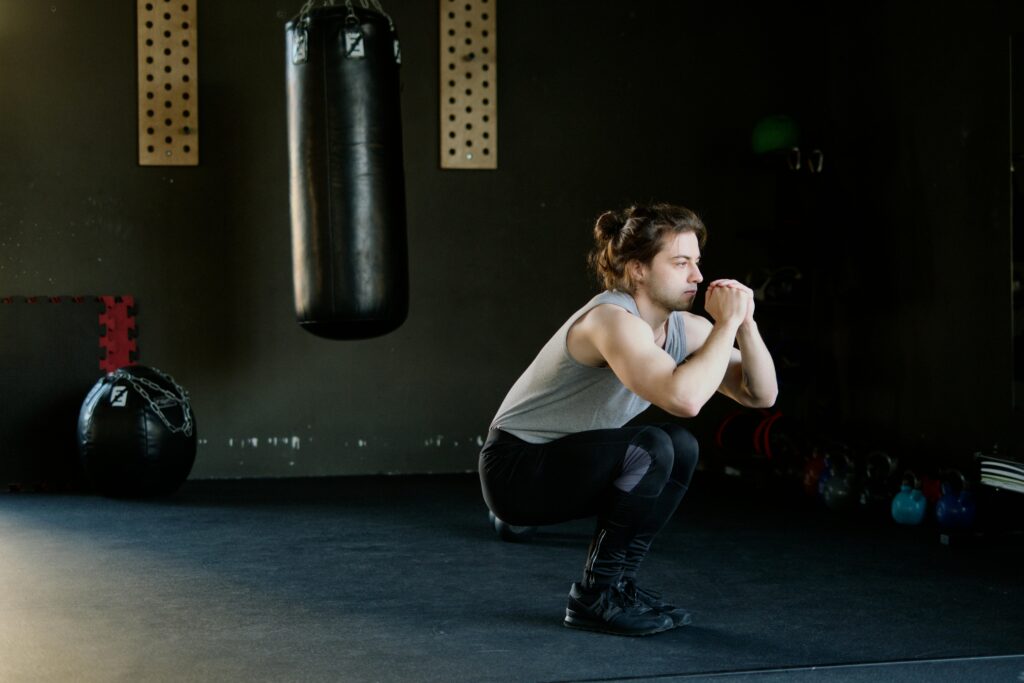
Month 5: 30-Day HIIT Challenge
High-Intensity Interval Training (HIIT) is famous for packing a huge calorie burn and cardiovascular boost into a short workout. This makes it ideal for people with busy schedules or those looking to shed some extra pounds while building endurance.
How It Works
- Structure: A typical HIIT session alternates short bursts of intense exercise (20–45 seconds) with rest or low-intensity intervals (10–30 seconds).
- Exercises: Common HIIT moves include burpees, mountain climbers, squat jumps, and high knees.
- Frequency: Aim for 3–4 HIIT workouts per week, each lasting 15–20 minutes. Rest or do low-intensity cardio (like walking) on the other days to aid recovery.
Benefits
- Time-Efficient: You don’t need a 60-minute workout to see results. HIIT can be as short as 10 minutes but still deliver significant gains.
- Cardiovascular Health: The intense intervals push your heart rate up, improving cardiovascular capacity over time.
- Metabolic Boost: HIIT can elevate your metabolism for hours post-workout, aiding in fat loss.
Tips for Success
- Warm up thoroughly with dynamic stretches and light cardio.
- Cool down after each session with slow-paced movement and static stretching.
- Adjust intervals based on your fitness level; shorter high-intensity bursts might be better if you’re just starting out.
Completing 30 days of consistent HIIT workouts can result in improved stamina, fat loss, and a newfound appreciation for how quickly you can break a sweat.
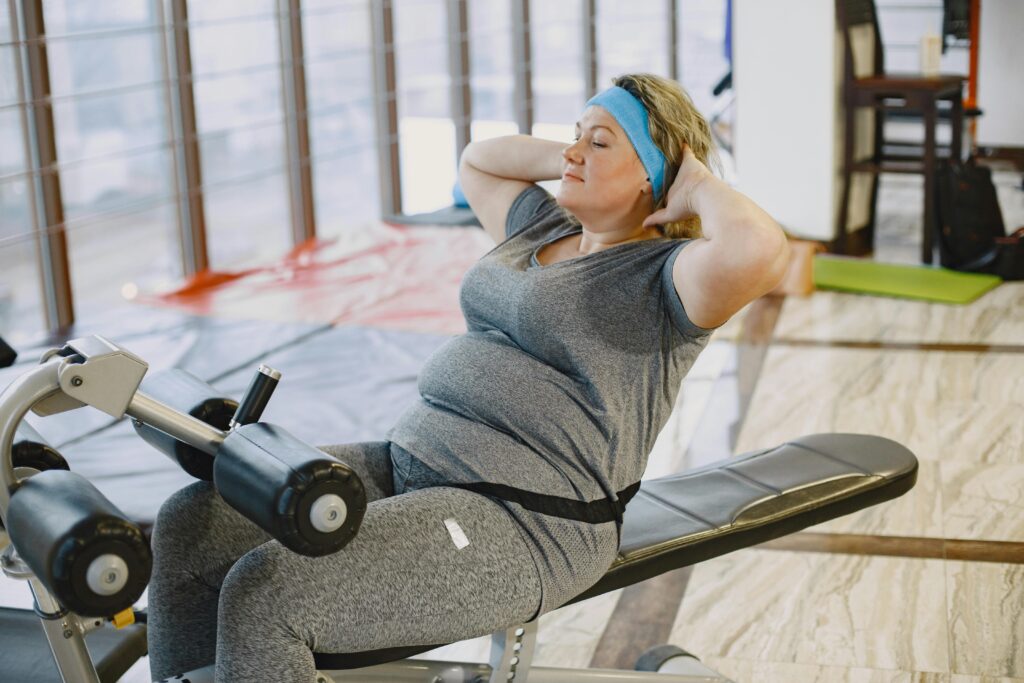
Month 6: 30-Day Ab Challenge
A strong midsection is about more than a six-pack aesthetic; it’s crucial for stability, balance, and spinal support. An ab-focused challenge can sharpen your core and complement your efforts from previous months.
How It Works
- Daily Core Work: Designate a short routine with exercises such as crunches, bicycle crunches, leg raises, and planks. Aim for 5–10 minutes of focused ab work each day.
- Incremental Difficulty: Increase reps or difficulty weekly. For instance, Week 1 might be 20 crunches per day, Week 2 bumps that to 30, and so on.
- Variety: Each day, rotate between different ab exercises to hit upper abs, lower abs, obliques, and the transverse abdominis.
Benefits
- Stronger Core: A dedicated ab challenge helps tighten and strengthen the muscles supporting your spine.
- Improved Posture: Core strength is vital for maintaining an upright posture, reducing strain on the lower back.
- Enhanced Athletic Performance: Almost every athletic movement—running, lifting, jumping—depends on core stability for efficiency and power.
Tips for Success
- Don’t neglect lower back exercises; incorporate supermans or bridges to maintain muscle balance.
- Control your movements—avoid yanking your neck or using momentum.
- Combine this challenge with a balanced diet to see more defined abdominal muscles.
By the end of this month, you’ll have a firmer, more capable core ready to support you in other exercises, daily tasks, and upcoming challenges.
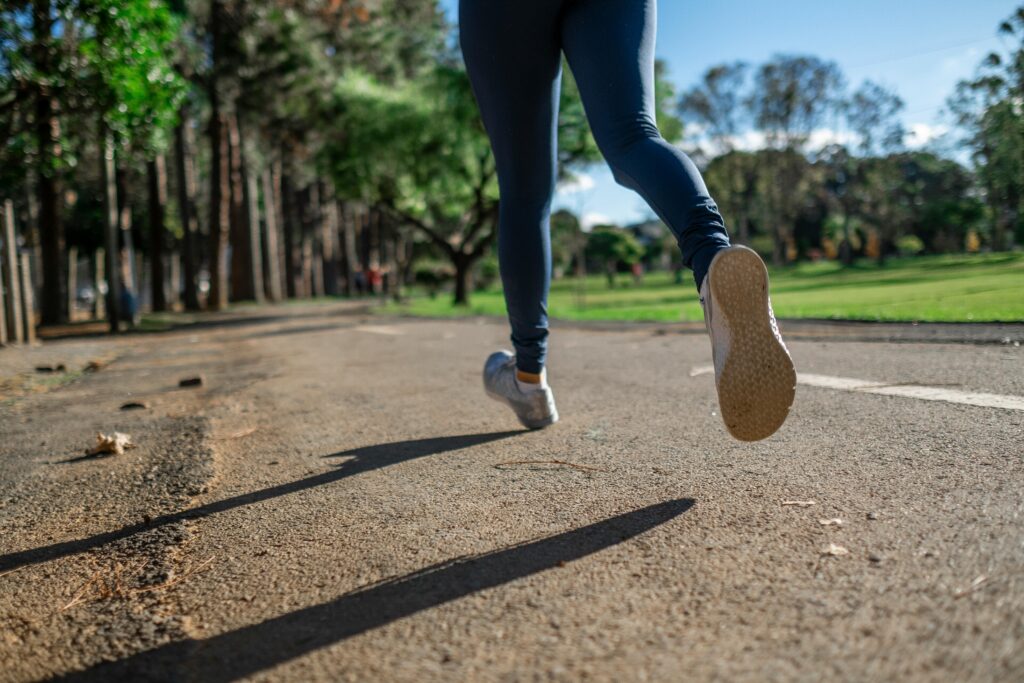
Month 7: 30-Day Running or Jogging Challenge
Mid-year is a great time to take your workouts outdoors if you can. A running or jogging challenge can boost cardiovascular health, aid weight management, and serve as a refreshing change from indoor routines.
How It Works
- Set a Distance or Time Goal: For beginners, aim to jog continuously for 10 minutes and increase by 1 minute each day or every other day. More advanced runners might set a distance goal—like running 50 or 100 total miles in 30 days.
- Consistency Is Key: Try to run/jog at least 3–5 days a week. Plan rest or cross-training days to prevent injuries.
- Progressive Overload: Gradually increase either your running duration or speed. Too much too soon can lead to overuse injuries.
Benefits
- Cardiovascular Endurance: Running improves heart and lung function, increasing overall stamina.
- Mental Health Boost: Outdoor running often has mood-elevating effects; fresh air and sunlight can help reduce stress and anxiety.
- Calorie Burn: Consistent running is an effective way to maintain or achieve a healthy weight.
Tips for Success
- Invest in good running shoes and replace them every 300–500 miles.
- Use proper running form: relaxed shoulders, mid-foot strike, and a slight forward lean.
- Hydrate adequately and consider fueling strategies for runs longer than 30 minutes.
A 30-day running challenge can transform your aerobic capacity and turn running into a habit you look forward to each week.

Month 8: 30-Day Jump Rope Challenge
Jump rope isn’t just for kids on the playground; it’s a fantastic, high-intensity cardiovascular workout that boosts coordination and speed. A 30-day jump rope challenge can be a fun, nostalgic way to continue building cardio strength.
How It Works
- Baseline: See how many consecutive jumps you can perform without tripping or stopping on Day 1.
- Steady Progress: Set a target of daily jumps, starting with a manageable number and slowly increasing. For example, begin at 50 daily jumps and add 10 each day.
- Intervals: As you advance, incorporate intervals of faster jumping or one-leg hops to keep it interesting.
Benefits
- High-Calorie Burn: Jump rope is known for torching calories in a short time, making it efficient for weight management.
- Improved Coordination: Timing your jumps with wrist rotation helps develop better rhythm and agility.
- Leg and Shoulder Endurance: Jumping rope requires constant engagement of your calves, quads, and shoulders.
Tips for Success
- Make sure your rope is the correct length: when you stand on it, the handles should reach around chest level.
- Jump on a shock-absorbing surface, such as a mat or wooden floor, to reduce impact on your joints.
- Keep your elbows close to your sides, and let your wrists do most of the work.
After 30 days, your cardio fitness, agility, and coordination will have taken a noticeable leap forward.

Month 9: 30-Day Flexibility Challenge
Flexibility is often overlooked in fitness routines, but it’s crucial for injury prevention and improved range of motion. A 30-day flexibility challenge will complement any strength or cardio work by focusing on stretching and mobility.
How It Works
- Daily Stretching Routine: Dedicate 10–15 minutes a day to dynamic and static stretches. Target key tight areas like hamstrings, hip flexors, shoulders, and back.
- Progressive Depth: Each week, aim to sink a bit deeper into your stretches without forcing or bouncing.
- Combination Techniques: Incorporate foam rolling, mobility drills, and perhaps even light yoga poses.
Benefits
- Injury Prevention: Flexible muscles and tendons are less prone to tears and strains.
- Enhanced Performance: Greater range of motion can boost performance in exercises like squats and lunges.
- Pain Relief: Stretching tight muscles (especially in the hips and lower back) can alleviate chronic pain.
Tips for Success
- Always warm up lightly before deep stretching—cold muscles are more susceptible to injury.
- Breathe deeply and consistently to help muscles relax.
- Track your progress with simple tests, like how far you can reach in a hamstring stretch.
By the end of this challenge, you’ll likely experience less stiffness, better posture, and an enhanced sense of comfort in everyday activities and workouts alike.

Month 10: 30-Day Walking Challenge
Walking is a low-impact, accessible form of exercise suitable for almost anyone. A dedicated walking challenge might seem simple, but consistency can yield significant improvements in cardiovascular health and mental well-being.
How It Works
- Goal Setting: Aim for a certain number of steps (e.g., 8,000–10,000) or a set distance each day. Fitness trackers or smartphone apps can help.
- Incremental Growth: If you’re new to walking regularly, start with 15–20 minutes daily and add 5 more minutes each week.
- Varied Terrain: Incorporate hills, trails, or treadmills to keep your walks interesting.
Benefits
- Low-Impact Cardio: Walking places less stress on your joints compared to running, making it ideal for beginners or those with joint concerns.
- Mental Health Boost: Walking can serve as meditation on the move; it’s relaxing and helps clear your mind.
- Weight Management: While it might not burn as many calories as running, consistent walking contributes to energy expenditure and better weight control.
Tips for Success
- Wear supportive shoes to prevent foot and ankle pain.
- Keep a brisk pace to elevate your heart rate; you should still be able to hold a conversation.
- Invite friends or family to join, turning your walks into a social activity.
After a month of daily walks, you’ll likely see improved mood, better endurance, and perhaps a few inches lost from your waistline.

Month 11: 30-Day Lunge Challenge
Lunges target almost every muscle in your lower body, from the quads and hamstrings to the glutes and calves. Adding core engagement for balance, lunges are a powerful functional movement to include in your routine.
How It Works
- Daily Reps: On Day 1, see how many lunges (per leg) you can perform before form suffers. Use this as your baseline.
- Incremental Increases: Add 2–3 lunges per leg each day or follow a structured calendar that incorporates rest days.
- Variations: Explore forward lunges, reverse lunges, walking lunges, and lateral lunges for a well-rounded workout.
Benefits
- Lower-Body Strength: Lunges shape and strengthen your quads, hamstrings, and glutes.
- Core Stability: Maintaining balance during a lunge engages your core, improving overall stability.
- Functional Movement: Lunges mimic real-life actions like climbing stairs or stepping forward, translating to better everyday mobility.
Tips for Success
- Keep your torso upright and your front knee tracking over your toes.
- Push off with your front heel to target your glutes more effectively.
- If balance is an issue, hold onto a sturdy chair or wall for support until you gain confidence.
By month’s end, you’ll feel stronger and more stable, ready to tackle stairs, hikes, and any activity that demands lower-body strength.
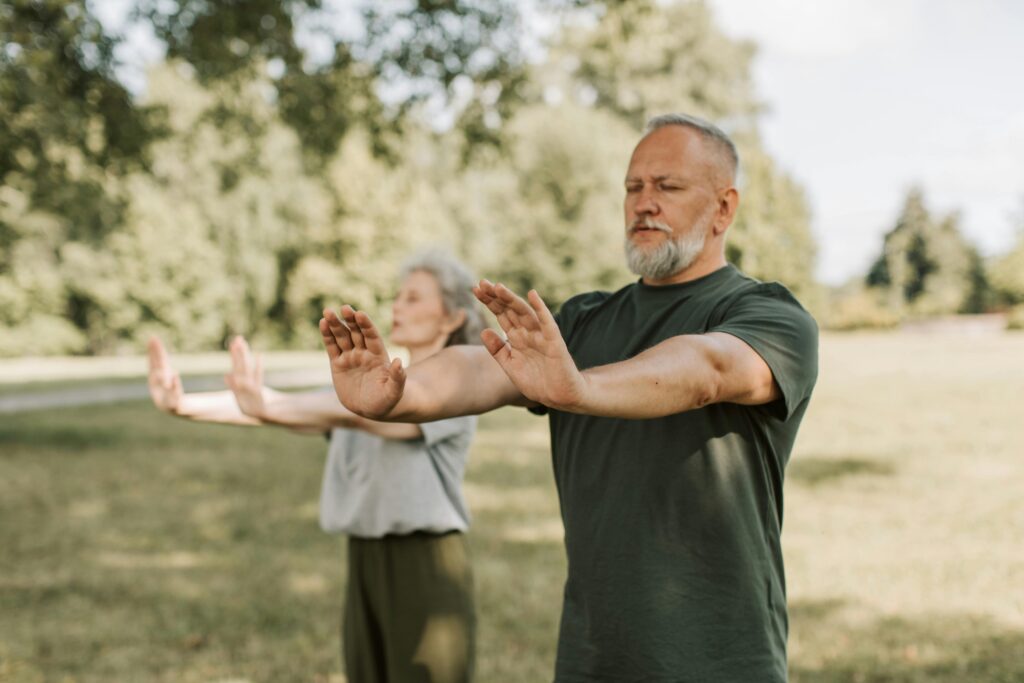
Month 12: 30-Day Mindful Movement Challenge
Ending the year with a mindful movement challenge can help you integrate the fitness gains you’ve made throughout the previous months with a focus on mental well-being and body awareness.
How It Works
- Mindful Sessions: Spend 10–15 minutes daily performing slow, deliberate movements—this could be Tai Chi, gentle yoga flows, or simple stretching routines with an emphasis on breath and body awareness.
- Meditative Element: Pair each movement with deep, controlled breathing. Keep your mind centered on the present moment and the sensations in your body.
- Journaling: Record daily reflections—what you felt physically and mentally—after each session.
Benefits
- Stress Reduction: Integrating mindfulness into movement has been shown to lower stress hormones and improve emotional balance.
- Enhanced Body Awareness: You’ll become more attuned to how your body feels, helping to prevent overtraining and injuries.
- Recovery and Mobility: Slow, controlled movements can assist with muscle recovery, reduce stiffness, and support flexibility.
Tips for Success
- Choose a calm, quiet environment for your sessions—if possible, a space without distractions.
- Focus on inhaling during expansion movements and exhaling during contraction movements.
- Consider using guided audio or videos for structure if you’re new to mindful movement practices.
By the close of this final monthly challenge, you’ll not only feel physically fit but also carry a sense of mental clarity and calm into the new year.
Conclusion
Completing a series of 12 monthly workout challenges is no small feat. Each month, you tackled a new focus—whether that was developing core strength, boosting cardiovascular endurance, increasing flexibility, or integrating mindfulness. The cumulative effect of these challenges extends far beyond any single 30-day period. Every squat, plank, push-up, and mindful breath gradually built upon your fitness foundation, ensuring that you’re stronger, leaner, and more attuned to your body than you were at the start.
Perhaps the biggest takeaway is the power of consistency. These short, month-long challenges can teach you the habit of showing up daily or weekly, even when life gets hectic. By setting clear goals and tracking your progress, you’ve learned how small steps taken consistently can yield substantial results over time. Moreover, varying the challenges each month kept your routine fresh and fun, staving off boredom and preventing plateaus.
Looking back, you might notice improvements not just in your physical strength and endurance but also in how you handle stress and in your overall energy levels. You’ve likely developed a greater appreciation for the incredible things your body can do when trained thoughtfully and progressively. Whether you decide to repeat some of these challenges, explore new workouts, or integrate multiple components into a routine, remember to keep that spark of curiosity alive. Fitness is a journey, and every challenge is another milestone, guiding you toward a healthier, happier life.
Congratulations on making it through a year’s worth of diverse, targeted challenges! Here’s to continued success, perpetual self-improvement, and the lasting positive impact of staying active, month after month.


